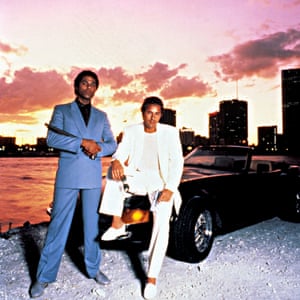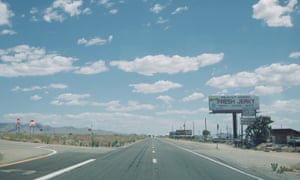Don’t Lose Your Mind by Miles Davis
My dad passed away in December 2019. Shortly before he died, after reading my book Afropean, Dad told me to listen to Miles Davis’s output during the 1980s, specifically “the Miles Davis reggae track” from the album Tutu. Despite winning a Grammy, this album emerged during Davis’s late period, when his star was burning out (with a cameo as a pimp in Miami Vice, and so on), and isn’t necessarily the era jazz aficionados look to when talking about Miles. To me, though, it evokes a sort of experimental, peripheral black space – out of sync with expectations, yet the ultimate expression of the African diaspora. I could imagine this music providing the score to an independent film noir by Melvin Van Peebles, for instance. Tutu transports me to that imaginative African geography known as “the Black Atlantic”, and was the album that got me through 2020; don’t lose your mind, indeed. Thank you, Dad.
Glimmer in the Wind by Junichi Kamiyama

During this summer’s lockdown I spent some of my newly found spare time digitising my family’s old Video8 footage from our trips to Japan during the late 80s, when my dad was in the Asia tours of Starlight Express. As I watched the tapes back, it occurred to me to try Shazaming some of the ambient music playing in the background in footage of our strolls through various futuristic shopping plazas and hotel lobbies. Using 21st-century technology, these mysterious, anonymous jingles from Japan in the late 20th century were suddenly revealed to me. This piece, what I now know to be Glimmer in the Wind by Junichi Kamiyama, was playing in footage of me as a five-year-old wandering through an aquarium at the top of a Tokyo skyscraper. I was able to pass on this soundscape to my daughter, who was born to it in October.
Cry by Godley and Creme

We spent the first lockdown with my mom in Sheffield, where a guilty pleasure of mine was watching Miami Vice on her TV. Whatever you want to say about the glorification of violence and the stereotyping of communities, what remains, even if unintentionally, is a portrait of everyone’s idea of what the 1980s were and specifically of the city of Miami. It was a joy to spend my evenings in seedy discotheques, hinterlands of faded art deco in pastel colours, and flickering neon signs. And the cameos! Miles Davis, Frank Zappa, James Brown, Isaac Hayes and Sheena Easton all made unexpected and often hilarious appearances. But the real reason to justify watching Miami Vice is the soundtrack – it’s a guide through the era’s hits and misses. In one haunting episode, in a beach scene at the end, Godley and Creme’s Cry is playing in the background and I had that lovely, vague recollection you get when you half-remember a half-hit from the past.
The Sea by Morcheeba
My brother and sister are 12 and 11 years older than me respectively, so though I’m technically millennial I’ve always identified more with Generation X, especially when it comes to music. Generation X had their dark moments, don’t get me wrong, but there was certainly a feeling that the future, even if dystopian, was a multicultural one. I have an iTunes playlist called Backpacker Bliss, which is a compilation of mellow, travel-inspired trip-hop and electronic music between 1998 and 2001, stuff from The Beach soundtrack, Air, Sneaker Pimps and so on. This music was made during an era of optimistic globalisation, before 9/11 laid bare the cultural and geopolitical fractures beneath it all. Perhaps the most evocative album from this era is Morcheeba’s Big Calm, which spawned the single The Sea, used as the opening for the early seasons of Channel 4’s Shipwrecked. When I hear it I think of beach parties in the late 1990s that I never attended.
Dumb by Jam Baxter Feat. Trellion & Lee Scott
I’ve followed Lee Scott and some of the other members who make up or collaborate with the mega crew Cult of The Damned with interest since the mid-00s, when they individually began emerging into the underground UK hip-hop scene. The collective is a site of intergenerational multiculturalism, bridging the north-south divide, though certainly not a pretty one – they are the younger inheritors of a globalisation gone wrong, and their music often sounds like glitchy post-trip-hop. Jam Baxter – linked to COTD through the Blah Records label – made the album this track is from when the crew took a trip out to Thailand and stayed in a little hotel called 38 Mansion, got off their heads and made music and music videos. The result, sardonic nihilism, seems such an honest response to a chaotic world. I listen to it to siphon such emotions out of me.
Moomin TV soundtrack by Sumio Shiratori

As the father of a five-year-old and a newborn, I’m always thinking of ways we can enjoy hanging out without it being forced. It’s a matter of meeting halfway – I don’t want to pretend I love Frozen; my five-year-old doesn’t want to sit through Chris Marker’s experimental 1980s documentaries. In Tampere, Finland, however, I found an elegant compromise when I stumbled into the Moomin Museum, and discovered the care and thought that Tove Jansson put into her characters (each one represents a different faction of society – Sniff the Capitalist, Snufkin is based on Janson’s old socialist mate, Too-Ticky is queer, etc).
The Japanese animated series of The Moomins is one of many great collabs between Europe and Japan during the 80s and 90s, and both cultures deal beautifully with the passing of seasons, so the series is visually rich and conjures atmospheres with Sumio Shiratori’s wonderful soundtrack. The winter episodes especially whisk me off to the Swedish/Finnish border, where I took my mom to stay in the Ice Hotel and see the aurora borealis.
Ballade (théme principal) by Stéphane Grappelli
I have an obsession with the music and graphic design of a series of CDs released by Universal Music Jazz France called Écoutez le Cinéma!, which focuses on mostly French film soundtracks of the 60s, 70s and 80s. This particular song is from the soundtrack to Les Valseuses, one of the most outrageous French films ever made. Though I remember finding it enjoyable when I watched it as a teenager, defending it as an adult in 2020 is untenable, but Stéphane Grappelli’s soundtrack distils some of the film’s unsavoury moments into the more innocent notions that first attracted me to the film – bohemian freedom, a sense of youthful whimsy, life beyond the confines of conservative norms. More specifically, the lazing, raffish soundtrack (which has a sort of French gypsy jazz feeling) – despite being made for a movie set in Valence – reminds me of the south of France, specifically Marseille, where I was living until lockdown.
Learn to Fly by FKJ Feat. Jordan Rakei

A rare moment of glamour for me this year came when I had my first solo exhibition of photographs at Foam gallery, Amsterdam. I was put up in a really nice hotel, and every morning I would have a lovely posh breakfast at the roof terrace restaurant to the sound of Jordan Rakei. But I have even fonder memories of Rakei. I was introduced to his mellow soul music back in 2013. I was driving a campervan from Brisbane to Sydney, and stopped off in Byron Bay. I made friends with some local surfers and an overnight stay turned into a week, and nearly a lifetime. At one party I remember a guy saying, “Why don’t you stay, we could use a guy like you”, referring to a sustainable farming community he was part of. I saw an alternative life flash before my very eyes: disappear and live in Byron Bay. I had a flashback to this when I returned from Amsterdam and had to quarantine for two weeks, shortly after which my second daughter, Sylvie, was born. I’m glad I didn’t stay in Byron Bay, but I’ve been playing a lot of Jordan Rakei recently!
Paradise by Sade
I feel the UK often doesn’t really know what to do with black artists who subvert what is expected of them. Sade is taken seriously across the world, in places like France, the States, Japan, and so on, but in the UK she is often treated as a cheesy lounge music act. For me Sade is the perfect music for consolation during rough times. Rarely do you feel that everything is fine in a Sade track – there’s always an undercurrent of melancholy, and yet the songs are mellow and evocative, helping you work through sombre moments. Sade takes you all over the world; one minute you’re on the Nigerian coast, then you’re in a cocktail bar in New York City, then, as with Paradise, a street festival in Mexico City. The music video to this song is as lovely as Queen Sade herself.
Calling You by Jevetta Steele

In 2012 I took a road trip along old Route 66, through Arizona and Nevada to California. Two things amazed me. One was that Route 66 is not a tourist trap – it’s a real deserted highway on which you pass through ghost towns ruined by the advent of interstate highways. I nearly ran out of petrol when my satnav led me to an abandoned gas station, and spent an anxious 40 minutes driving on empty through the desert in midday heat without passing another car or human being. The second thing was the light. I’m a fan of photographers like William Eggleston and Stephen Shore, who have both captured the faded Americana in this part of America in beautiful colour photography. But seeing it with my own eyes made their work a little less special, because all the raw materials were there: the perfect blue skies and fluffy clouds, the old Chevys gleaming under the sun in primary colours, the decaying Pepsi logo – no wonder my photographs of Sheffield never looked as sumptuous! Calling You, from the film Bagdad Cafe (which inspired my trip), always brings back dusty, golden memories.





